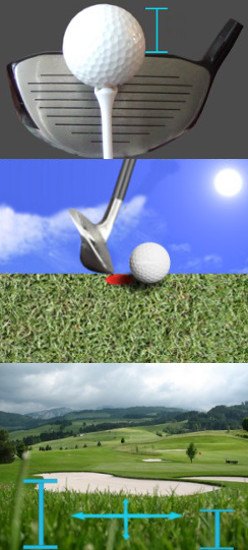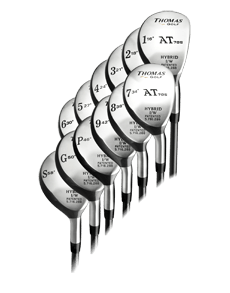Accuracy 
You are going to have to tailor your expectations with regard to accuracy based on the lie of the golf ball. One of the key skills you need to develop as a golfer is learning how to read different lies as they come up on the course.
This would be a relatively easy game if you always had a great lie, but of course, that is not the case. You are going to have to deal with some tough lies as you move forward in this game, and you’ll find that some of the trickiest lies don’t actually look that bad at first.
It is important to understand various types of lies because your understanding of these different lies will let you decide on the right course of action to move the ball toward the target.
If you try to play all of your shots the same way, you will inevitably be disappointed in the results. The list of techniques below should help you gain an understanding of how a few different types of lies should be approached.
- Tee shots. When on the tee, you should have a perfect lie each and every time. Since the ball will be played on top of a tee, you don’t have to worry about how the grass is going to affect your shot.
- Whether you tee the ball up high to hit a driver, or just over the top of the grass to hit an iron, you’ll be able to customize your lie exactly to your needs.
- Approach shots from the fairway. Most of the time, you can be confident that your lie in the fairway is not going to cause any issues. Unless you get unlucky and your ball stops in a divot, playing from the fairway is an ideal situation.
- You should be able to get plenty of spin on the shot, and you should be able to control your trajectory (assuming your swing technique is up to the job, of course). If all you had to do on the course was hit tee shots and approaches from the fairway, life as a golfer would be pretty simple.
- Playing from short rough. This is perhaps the toughest situation of all for the average golfer. On the surface, this kind of lie doesn’t look that bad. Sure, the ball is sitting in grass that is longer than the fairway cut, but you can still see almost all of the ball. It seems like you should be able to make good contact, so what’s the problem?
- Even though the lie doesn’t look bad, you have lost a significant amount of your control just by having to play from this kind of lie. The ball isn’t going to spin as much, meaning it will be harder to control the distance, and you won’t be likely to get your normal shape on the shot, either. As a general rule of thumb, you will be well-served to give these kinds of shots plenty of respect by picking safe targets and playing them conservatively.
- Playing from long rough. Shots hit from long rough are difficult, but the decision-making process is actually a bit easier than it is in the short rough. When in the long rough, you’ll know you are in for a challenge.
- You probably won’t be able to hit the ball your usual distance, so a layup is the likely choice. Shots hit from long grass are going to have very little spin, meaning the ball is likely to bounce and roll after it lands. The main objective from here is to just get the ball back in play, finding some short grass for your next shot.
It should go without saying that the four options above are just the tip of the iceberg when it comes to the types of lies you can draw on a golf course. You’ve probably already experienced many other kinds of lies, and you’re sure to find even more new ones as you continue to play this game. Each time you draw an unusual kind of lie, think it through and always err on the safe side. Your accuracy is typically going to be decreased when your lie is questionable, so proceed with caution and avoid a big mistake.
Accuracy in golf is influenced by various factors, including the lie of the golf ball. The lie refers to how the ball is sitting on the ground, whether it's on the fairway, in the rough, in a bunker, or on an uneven surface. Here's how the lie can affect accuracy and what you can do to adjust:
- Fairway Lie: When the ball is sitting on the fairway, it provides the ideal conditions for accuracy. The even lie allows you to make clean contact and have more control over your shots. Focus on aligning yourself properly to the target, select the appropriate club, and make a smooth and balanced swing.
- Rough Lie: When the ball is in the rough, accuracy can be compromised. The longer grass can grab the clubhead and affect the ball's trajectory and spin. To improve accuracy from the rough, select a club with enough loft to clear the grass and make a steeper swing. Grip the club more firmly and make a more aggressive swing to ensure solid contact.
- Bunker Lie: In a bunker, the lie can vary depending on how the ball is sitting in the sand. Accuracy becomes crucial to control the distance and trajectory of the shot. Open the clubface slightly to increase the loft and use an open stance to promote a more vertical swing path. Focus on striking the sand a few inches behind the ball and follow through with a full swing.
- Uphill/Downhill Lie: When the ball is on an uphill or downhill lie, accuracy can be challenging. Adjust your setup and swing accordingly to adapt to the slope. For an uphill lie, position the ball slightly forward in your stance and make a steeper swing to ensure solid contact. For a downhill lie, position the ball slightly back in your stance and make a more sweeping swing to avoid hitting the ground before the ball.
- Uneven Lie: An uneven lie, such as on a sidehill or uphill/downhill slope, can significantly affect accuracy. Assess the lie and make adjustments to your stance, alignment, and swing to compensate for the slope. Aim to keep your balance and maintain a stable base throughout the swing.
Remember, practicing different lies and adapting your technique accordingly can improve your accuracy. Understanding how the lie affects your shots and making the necessary adjustments will help you make more accurate and consistent shots on the golf course.






